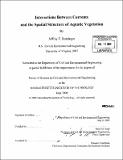Interactions between currents and the spatial structure of aquatic vegetation
Author(s)
Rominger, Jeffrey T. (Jeffrey Tsaros)
DownloadFull printable version (31.77Mb)
Other Contributors
Massachusetts Institute of Technology. Dept. of Civil and Environmental Engineering.
Advisor
Heidi M. Nepf.
Terms of use
Metadata
Show full item recordAbstract
Vegetation is present in nearly all aquatic environments, ranging from meandering streams to constructed channels and rivers, as well as in lakes and coastal zones. This vegetation grows in a wide range of flow environments as well, from stagnant water to highly turbulent flows dominated by waves and currents. Feedbacks between the dominant currents and the vegetation not only significantly alter the velocity structure of the flow, but play a large role in determining the spatial structure of the vegetation as well. This thesis examines these interactions through field experiments, review of existing literature and theoretical and analytical models. The first study describes a set of experiments in which vegetation was added to the point bar of a stream meander during base flow. During the next flood event, this vegetation proved to be destabilizing as a portion of the vegetation scoured away and the cross section of the open channel showed clear patterns of erosion. The secondary circulation present in the meander was significantly altered as well. In the second study, the relationship between tidal currents and the spatial distribution of seagrass meadows is examined. Seagrass beds range in their coverage from continuous meadows, to spotty swaths dominated by discrete patches. The relationship between this area coverage and tidal currents, explained by the principles of percolation theory, helps describe why certain distributions of seagrass within a meadow are more stable than others. (cont.) Drawing on the principles and examples established in the first two sections, the final section describes an analytical model for predicting vegetation coverage in a rectangular open channel. The model can allow for fixed banks, such as those in a concrete-lined channel, or can allow erosion of the boundaries, as is possible in natural streams. These two versions of the model show notably different results. Ultimately, this thesis presents multiple cases of the interactions between currents and aquatic vegetation and showcases an important example of a multi-disciplinary research approach in fluid mechanics.
Description
Thesis (S.M.)--Massachusetts Institute of Technology, Dept. of Civil and Environmental Engineering, 2009. Includes bibliographical references (p. 79-85).
Date issued
2009Department
Massachusetts Institute of Technology. Department of Civil and Environmental EngineeringPublisher
Massachusetts Institute of Technology
Keywords
Civil and Environmental Engineering.